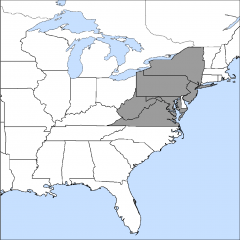Sycamore - River Birch Floodplain Forest (Piedmont-Central Appalachian)
Learn More
The Sycamore - River Birch Floodplain Forest is a natural community of stunted and sparse trees, mostly American sycamore and river birch, growing on gravel bars alongside rivers. The trees bear evidence of repeated flooding. Low plants include the flood-tolerant American water-willow, blue mistflower, and halberd-leaf rosemallow. (There is more than one type of Sycamore - River Birch Floodplain Forest; this type is found in the Piedmont and Central Appalachians.)
This natural community is primarily found along rivers and large streams in the Piedmont and central Appalachian Mountains from West Virginia and Virginia to New York.
The range map shows the states in which this natural community has been documented.
More About This Natural Community
The Sycamore - River Birch Floodplain Forest grows on sand, cobbles, and gravel deposited by rivers. The regular influx of new sediment creates a fertile setting for plants. However, swift-running floodwaters make it hard for plants to hold on and keep growing.
The canopy in the Sycamore - River Birch Floodplain Forest is stunted and sparse, due to frequent strong flooding. Trunks may be scarred on the upstream side, from debris in floods and ice. Many trees are growing at an angle because they’ve been pushed over by floods. American sycamore and river birch are the most common trees, although you may also see green ash, silver maple, and black willow. The sparse layer of low plants contains flood-tolerant species such as blue mistflower and halberd-leaf rosemallow.
For a more in-depth look at this community, click on a link under “Where to Explore It.”
Look for It in These National Parks
- Appalachian Trail (Central Appalachians)
- Chesapeake and Ohio Canal National Historical Park
- Delaware Water Gap National Recreation Area
- George Washington Memorial Parkway
- Harpers Ferry National Historical Park
- Manassas National Battlefield Park
- Monocacy National Battlefield
- Upper Delaware Scenic & Recreational River
Conservation Status
How vulnerable is a natural community? Is it at risk of elimination? Learn about conservation status.
Classification
Official names reduce confusion by providing a common language for talking about natural communities. Why so many names?



